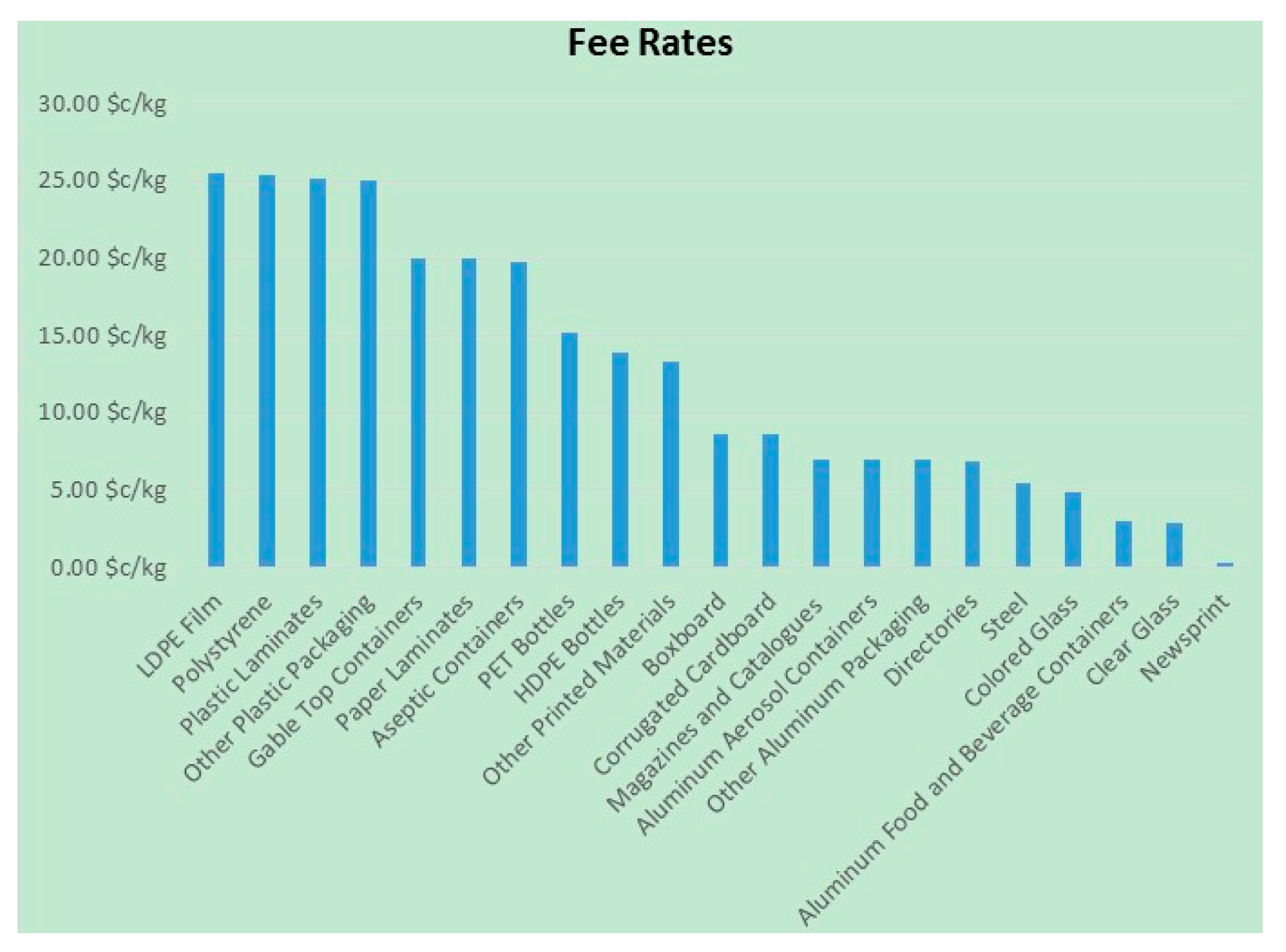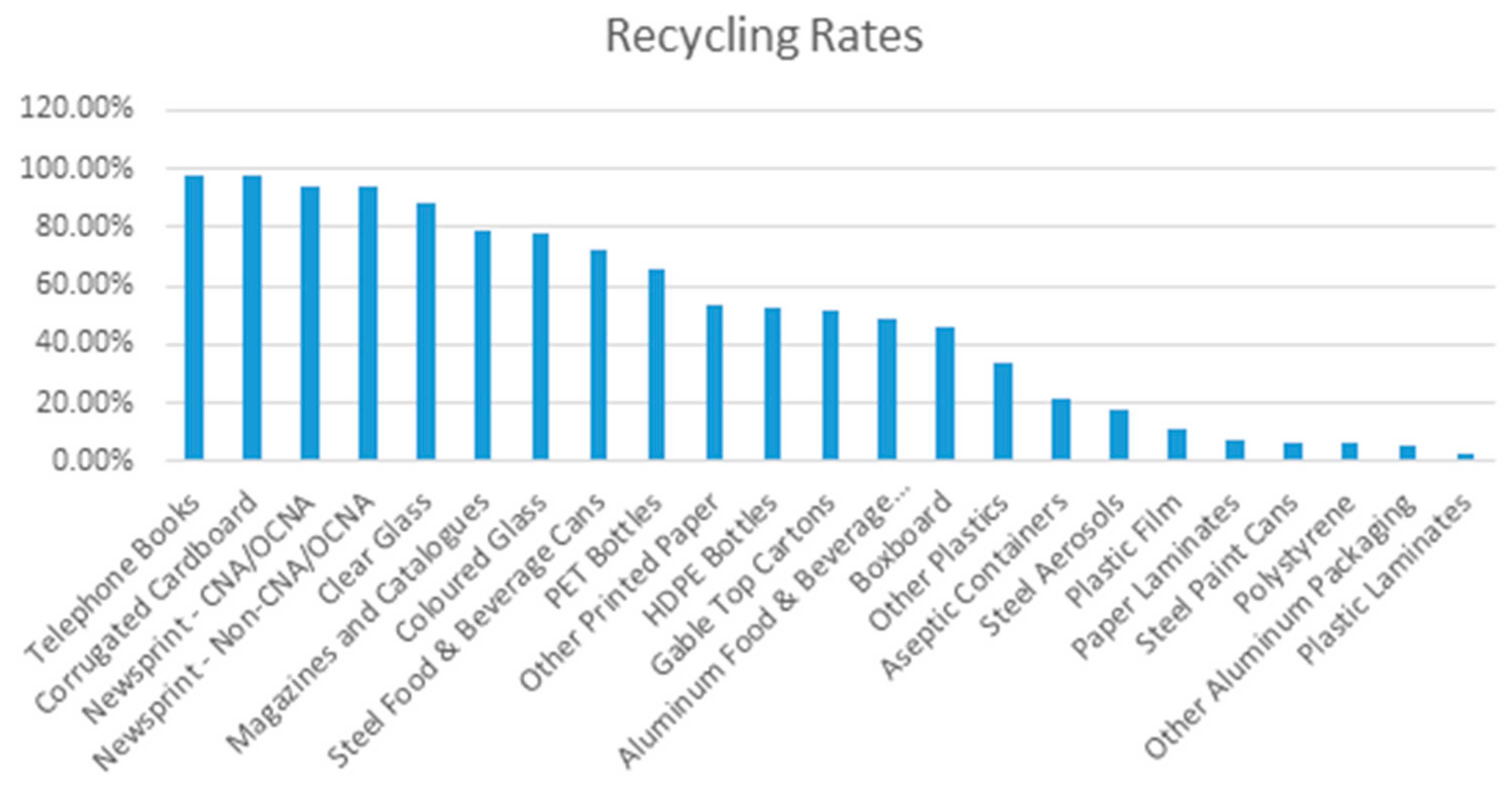Do Eco-Fees Encourage Design for the Environment? The Relationship between Environmental Handling Fees and Recycling Rates for Printed Paper and Packaging
Abstract
:1. Introduction
2. Literature Review
- To transfer the costs of managing packaging waste from the local tax base to the producer and user of the product.
- To provide a direct economic incentive for the producer of the package to reduce packaging materials and design packaging for improved recyclability.
- As an initial step towards the development of a circular materials economy—where waste materials serve as feedstock for new processes (as opposed to the current norm: a linear extraction/production/consumption/disposal economic system).
- To make the producer and consumer of the packaging fully responsible for the environmental impacts of it production, use and EOL management.
3. Materials and Methods
3.1. Description of Study Site
3.2. Description of Stewardship Ontario Fee Model
- Determine Blue Box Program Costs
- Allocate Costs to Individual Materials
- Determine Fee Rates
- 20% of the cost of the program is assigned to each material category based on the net cost of managing each material in the system;
- 55% of the cost of the program is assigned based on the recovery rate achieved by that material;
- 25% of the cost of the program is assigned based on how much it would cost to manage the material if it were recovered at a rate of 60% (only applies to materials achieving less than 60% target rate) [16].
- Newsprint
- Magazines and Catalogs
- Telephone Books
- Other Printed Paper (e.g., Office paper)
- Corrugated Cardboard
- Boxboard
- Gabletop Cartons (e.g., milk and orange juice containers)
- Aseptic Containers (e.g., juice boxes)
- Paper Laminants (e.g., coffee cups)
- PET (Polyethylene terephthalate) Bottles (e.g., water bottles)
- HDPE (High density polyethylene terephthalate) Bottles (e.g., laundry detergent)
- Plastic Film (e.g., grocery bags)
- Plastic Laminants (e.g., chip bags)
- Polystyrene
- Other Plastics (e.g., margarine tubs and lids)
- Steel Food and Beverage Cans
- Steel Aerosols
- Steel Paint Cans
- Aluminum Food and Beverage Cans
- Other Aluminum Packaging
- Clear Glass
- Colored Glass
4. Results
Statistical Analysis
5. Conclusions
Conflicts of Interest
References
- Lindhqvist, T.; Lifset, R. Can we take the concept of individual responsibility from theory to practice? J. Ind. Ecol. 2003, 7, 3–6. [Google Scholar] [CrossRef]
- Gertsakis, J. Industrial ecology and extended producer responsibility. In A Handbook of Industrial Ecology; Ayres, R.U., Ayres, L.W., Eds.; Edward Elgar Publishers: Cheltenham, UK, 2002; pp. 27–35. [Google Scholar]
- Mayers, K. Strategic, financial, and design implications of extended producer responsibility in Europe: A producer case study. J. Ind. Ecol. 2007, 11, 113–131. [Google Scholar] [CrossRef]
- Deutz, P. Producer responsibility in a sustainable development context: Ecological modernisation or industrial ecology? Geogr. J. 2009, 175, 274–285. [Google Scholar] [CrossRef]
- Mayers, K.; Lifset, R.; Bodenhoefer, K.; Van Wassenhove, L.N. Implementing individual producer responsibility for waste electrical and electronic equipment through improved financing. J. Ind. Ecol. 2013, 17, 186–198. [Google Scholar] [CrossRef]
- Walls, M. Extended Producer Responsibility and Product Design: Economic Theory and Selected Case Studies. Available online: http://ssrn.com/abstract=901661 (accessed on 10 November 2008).
- Gottberg, A.; Morris, J.; Pollard, S.; Mark-Herbert, C.; Cook, M. Producer responsibility, waste minimization and the WEEE Directive, Case studies in ecodesign from the European lighting sector. Sci. Total Environ. 2006, 359, 38–56. [Google Scholar] [CrossRef] [PubMed]
- Mayers, K.; Butler, S. Producer responsibility organizations development and operations. J. Indus. Ecol. 2013, 17, 277–289. [Google Scholar] [CrossRef]
- Stephenson, D. Internal White Paper on EPR (For Discussion Only). 2010. Available online: www.stewardedge.ca/content/archived/2010/EPRdiscussion.doc (accessed on 17 January 2016).
- Sheehan, B.; Spiegelman, H. EPR in the US and Canada. Resour. Recycl. 2005, 3, 18–21. [Google Scholar]
- Schwartz, J.; Gattuso, D. Extended Producer Responsibility: Re-Examining Its Role in Enviornmental Progress. Available online: http://www.rppi.org/ps293.pdf (accessed on 17 January 2016).
- Seidel, C. Zeroing in on Waste: The Role of Extended Producer Responsibility in a Zero Waste Strategy. Recycling Council of Alberta. From Recycling Council of Alberta. 2006. Available online: http://www.gpiatlantic.org/conference/proceedings/seidel.ppt (accessed on 27 February 2006).
- Pro Europe. Packaging and EU Directive on Waste. 2012. Available online: http://www.pro-e.org/2009-Q&A-Packaging-and-EU-Directive-on-waste.html (accessed on 10 November 2015).
- Waste Diversion Ontario. About WDO. 2012. Available online: http://www.wdo.ca/content/?path=page81+item35937 (accessed on 10 November 2016).
- Stewardship Ontario. Blue Box Annual Report. 2003–2015. Available online: http://www.wdo.ca/content/?path=page82+item35785 (accessed on 17 January 2016).
- Stewardship Ontario. Pay in Model. 2005–2015. Available online: http://www.stewardshipontario.ca/stewards-bluebox/fees-and-payments/fee-setting-flow-chart/the-pay-in-model/ (accessed on 17 January 2016).
- Waste Diversion Ontario. 2012 Ontario Residential Diversion Rates. 2014. Available online: http://www.wdo.ca/files/8413/9040/6230/Datacall_Diversion_Rates_2012.pdf (accessed on 17 January 2016).
- Breusch, T.S.; Pagan, A.R. A simple test for heteroscedasticity and random coefficient variation. Econometrica 1979, 47, 1287–1294. [Google Scholar] [CrossRef]
- Hausman, J.A. Specification Tests in Econometrics. Econometrica 1978, 46, 1251–1271. [Google Scholar] [CrossRef]
- Sidique, S.F.; Lupi, F.; Joshi, S.V. Factors influencing the rate of recycling: An analysis of Minnesota counties. Resour. Conserv. Recycl. 2009, 54, 242–249. [Google Scholar] [CrossRef]
- Oom do Valle, P.; Reis, E.; Menezes, J.; Rebelo, E. Behavioural determinants of household recycling participation. Environ. Behav. 2004, 36, 505–540. [Google Scholar] [CrossRef]
- Lakhan, C. The relationship between municipal waste diversion incentivization and recycling rate performance: An Ontario Case Study. Resour. Conserv. Recycl. 2016, 106, 68–77. [Google Scholar] [CrossRef]



| Approach | Countries | Trends |
|---|---|---|
| Producers pay 100% of costs | 15 | Move towards competing compliance schemes |
| Producers pay shared costs | 10 | Move to increasing industry cost share + costs of disposal for packaging not recycled |
| Tradable credits schemes | 2 | Provides only indirect price support for municipal recycling; focus on transport packaging |
| Packaging taxes | 2 | Add carbon costs as well as recycling costs; new government revenue source |
| Materials | 2003 Quantity Generated | 2013 Quantity Generated |
|---|---|---|
| (tonnes) | (tonnes) | |
| High Fee Materials | ||
| Gable Top Cartons | 14,249 T | 42,000 T |
| Paper Laminants | 2800 T | 39,205 T |
| Aseptic Containers | 5820 T | 12,800 T |
| Plastic Film | 53,700 T | 54,383 T |
| Plastic Laminants | 35,391 T | 35,391 T |
| Polystyrene | 20,400 T | 57,400 T |
| Other Plastics | 28,300 T | 70,790 T |
| Low Fee Materials | ||
| Newsprint–CNA/OCNA | 264,800 T | 217,375 T |
| Newsprint–Non-CNA/OCNA | 136,400 T | 148,405 T |
| Magazines and Catalogues | 95,100 T | 78,908 T |
| Telephone Books | 15,000 T | 8329 T |
| Other Printed Paper | 127,800 T | 128,245 T |
| Corrugated Cardboard | 140,000 T | 169,361 T |
| Boxboard | 130,500 T | 163,988 T |
| PET Bottles | 36,200 T | 56,848 T |
| HDPE Bottles | 23,000 T | 27,598 T |
| Steel Food & Beverage Cans | 57,800 T | 45,286 T |
| Steel Aerosols | 4300 T | 4079 T |
| Steel Paint Cans | 4800 T | 5072 T |
| Aluminum Food & Beverage Cans | 24,100 T | 22,552 T |
| Other Aluminum Packaging | 2408 T | 4521 T |
| Clear Glass | 76,200 T | 74,522 T |
| Coloured Glass | 6700 T | 25,277 T |
| Independent Variables | Packaging Materials (RR%) | Std. Error | Z Score |
|---|---|---|---|
| FR | 0.000136 | 0.0002 | 0.03 |
| REV | 0.29561 | 0.5868 | 3.90 |
| COST | −0.214564 | 0.2847 | 4.41 |
| Material | FR | REV | COST |
|---|---|---|---|
| Newsprint (Newspaper Association) | 0.000220 | 0.18690 | −0.14366 |
| Newsprint–(Not part of Newspaper Association) | −0.000070 | 0.34266 * | 0.13147 |
| Magazines and Catalogues | 0.000869 | 0.31110 * | −0.21833 |
| Telephone Books | −0.000435 | 0.32136 * | 0.27699 ** |
| Other Printed Paper | −0.000504 | 0.26247 ** | 0.29483 ** |
| Corrugated Cardboard | −0.000441 | 0.32004 * | −0.13283 |
| Boxboard | 0.000250 | 0.22784 | −0.28680 ** |
| Gable Top Cartons | 0.000351 | 0.37000 * | −0.30779 * |
| Paper Laminates | −0.000437 | 0.35511* | −0.12441 |
| Aseptic Containers | 0.000594 | 0.22920 | 0.32168 * |
| PET Bottles | 0.000251 | 0.13968 | −0.17759 |
| HDPE Bottles | 0.000628 | 0.21201 | −0.38966 * |
| Plastic Film | 0.000109 | 0.34974 * | −0.16741 |
| Plastic Laminates | −0.000880 | 0.25767 ** | −0.14192 |
| Polystyrene | 0.000933 | 0.27153 ** | −0.25416 |
| Other Plastics | −0.000896 | 0.20125 | 0.18090 |
| Steel Food & Beverage Cans | −0.000390 | 0.32253 * | −0.13927 |
| Steel Aerosols | −0.000180 | 0.12530 | −0.37894 * |
| Steel Paint Cans | 0.000650 | 0.24550 ** | −0.14989 |
| Aluminum Food & Beverage Cans | 0.000562 | 0.15814 | −0.10016 |
| Other Aluminum Packaging | −0.000114 | 0.11705 | −0.10969 |
| Clear Glass | −0.000514 | 0.11587 | 0.29892 ** |
| Coloured Glass | −0.000592 | 0.27944 ** | −0.32096 * |
© 2016 by the author; licensee MDPI, Basel, Switzerland. This article is an open access article distributed under the terms and conditions of the Creative Commons by Attribution (CC-BY) license (http://creativecommons.org/licenses/by/4.0/).
Share and Cite
Lakhan, C. Do Eco-Fees Encourage Design for the Environment? The Relationship between Environmental Handling Fees and Recycling Rates for Printed Paper and Packaging. Recycling 2016, 1, 136-146. https://doi.org/10.3390/recycling1010136
Lakhan C. Do Eco-Fees Encourage Design for the Environment? The Relationship between Environmental Handling Fees and Recycling Rates for Printed Paper and Packaging. Recycling. 2016; 1(1):136-146. https://doi.org/10.3390/recycling1010136
Chicago/Turabian StyleLakhan, Calvin. 2016. "Do Eco-Fees Encourage Design for the Environment? The Relationship between Environmental Handling Fees and Recycling Rates for Printed Paper and Packaging" Recycling 1, no. 1: 136-146. https://doi.org/10.3390/recycling1010136
APA StyleLakhan, C. (2016). Do Eco-Fees Encourage Design for the Environment? The Relationship between Environmental Handling Fees and Recycling Rates for Printed Paper and Packaging. Recycling, 1(1), 136-146. https://doi.org/10.3390/recycling1010136





